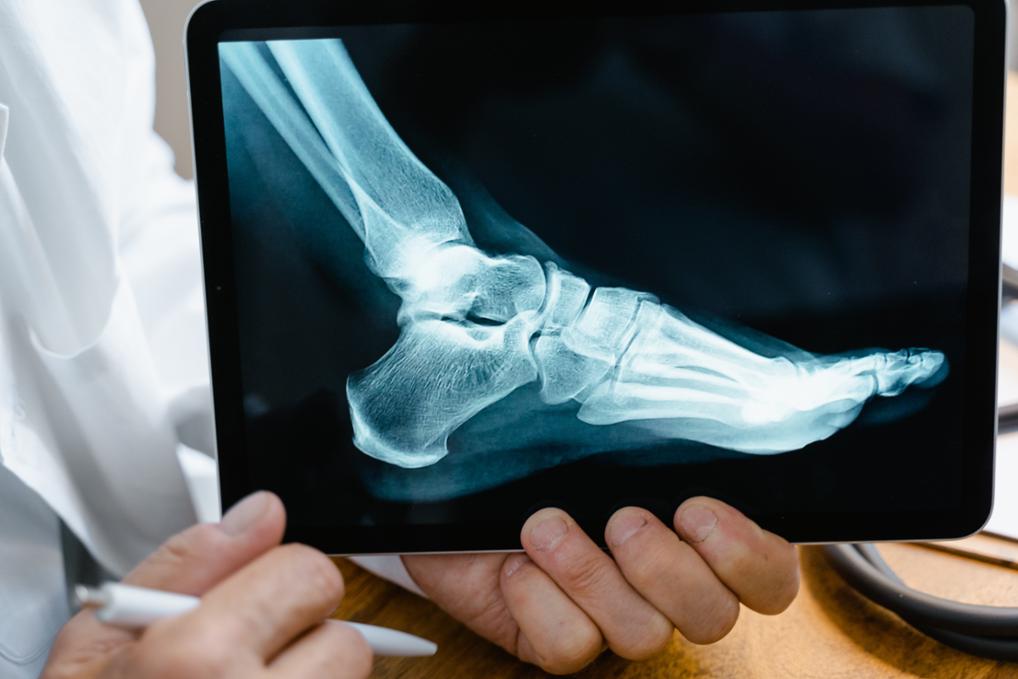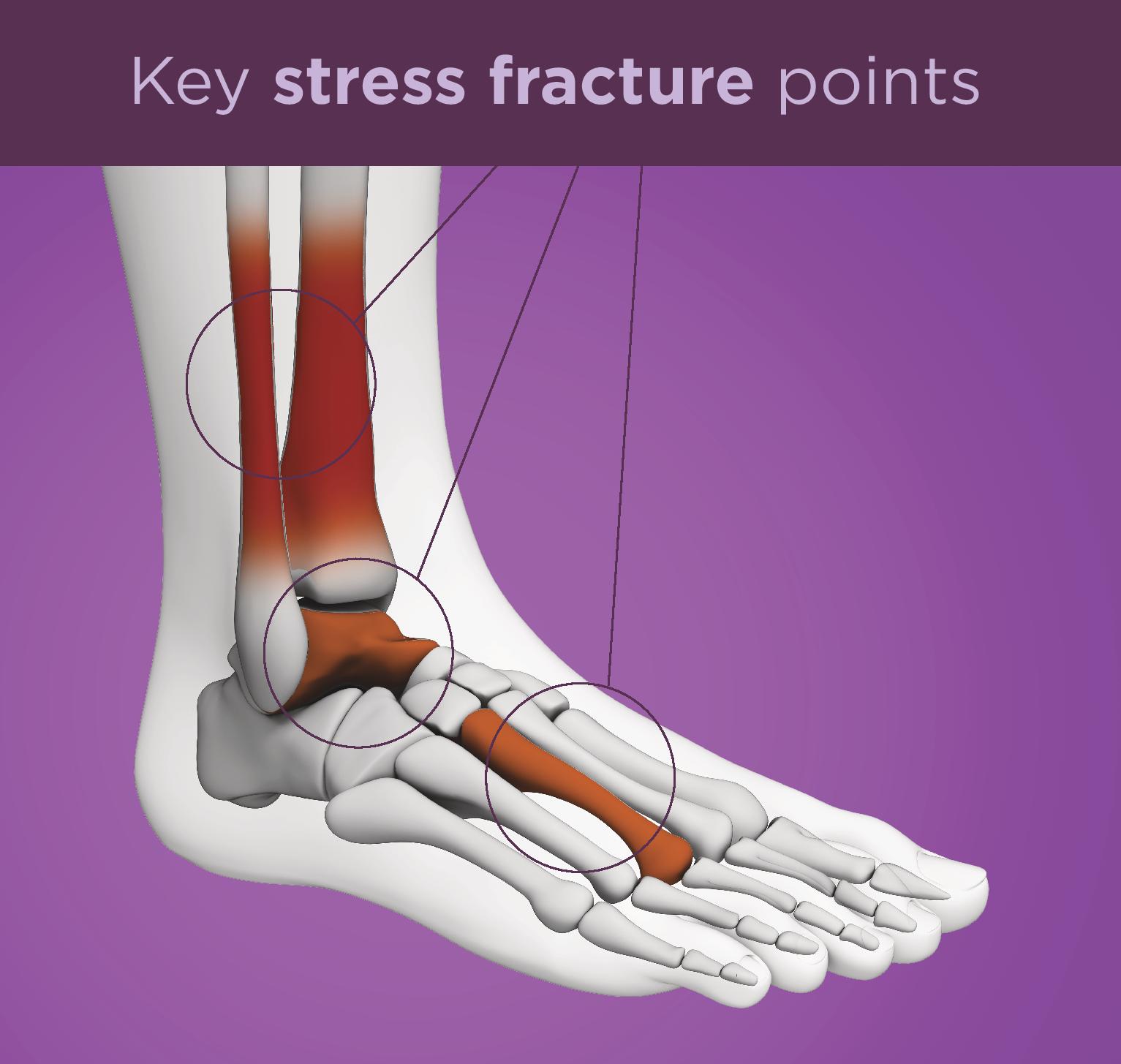Stress Fractures: The Risks You Must Know
Stress fractures make up between 10% and 20% of all injuries in sports medicine, and slightly more so in runners. This makes them an important area of focus for our podiatrists here at Waikato Podiatry. We’re sharing about them today because there’s a lot more than meets the eye when it comes to stress fractures that many people aren’t aware of, and understanding all the associated factors that put you at risk can go a long way in helping you prevent one - or at least reduce your risk.
So what exactly are stress fractures, how do you know if you have one, and how do they differ from regular “broken bone” fractures?
What Is A Stress Fracture?
A stress fracture is a small hairline crack in the bone, often appearing like a small web of cracks in one area. Unlike standard bone-break fractures that occur suddenly, unexpectedly and are usually related to trauma (like falling off a playground and breaking a bone), stress fractures are slow and steady, being caused by Repeated excess stress and loading over time, with forces being repetitively applied to bone past the point that the bone can withstand.
In their early stages, stress fractures remain very subtle, typically going undetected due to feeling just like a regular non-specific foot or leg ache. It’s not until they’ve grown bigger, more painful and it becomes more difficult to bear weight on the fractured foot that alarm bells are raised that there’s something more going on.
Stress fracture signs and symptoms
Most people with a stress fracture find it difficult to recall the exact moment they noticed it, just citing that at some point an ache in their feet or legs began. You’ll notice the pain will worsen during weight-bearing activity and will feel better during rest. The pain will be localised to the area where the fracture has occurred and may radiate up or down the bone.
Stress fractures often occur in the feet and legs because of the impact forces and stress on these bones during exercise and everyday life. Common sites of stress fractures in the feet and legs include the shin bone (tibia), the long bones of the feet (the metatarsals, which are the most common stress fracture site) and the heel bone (calcaneus).
Why Do Stress Fractures Occur? The ‘Inside’ Scoop
The simple answer, as we’ve mentioned above, is that when any bone is placed under excess pressure and stress repetitively, there’s a risk of a fracture developing because the bone is just not strong enough
to withstand those forces over and over. To better understand stress fractures and why you may feel like you’ve suddenly developed one without changing your routines too drastically, we need to get more technical.
While it’s easy to think of our bones as solid objects that don't change, it’s not the case. On a cellular level, the body is in a constant cycle of remodelling where it breaks down and rebuilds our bones. Doing so involves borrowing from the calcium stores of our bones and giving back to them - which is why calcium and minerals are such an important part of our diet for bone health.
When our bones are being broken down and rebuilt at the same rate, we maintain our existing bone strength throughout the remodelling process. When we load our bones more, like with weight-bearing exercise, the body responds to the added loading by rebuilding stronger bones that can handle the load we are regularly exposed to. In order to build stronger bones - or even maintain our current bone strength and remodelling rate - our body is influenced by things like our energy input from food, our hormones, even our rest - among a range of factors. So when it comes to the causes of a stress fracture, the story tends to go far beyond just exposing your bones to excessively heavy loads.
Stress Fracture Risk Factors
So what factors other than repetitively exposing your body to high loads during exercise as a result of training errors (which is thought to be the most common cause of stress fractures), can then lead to a stress fracture?
- Insufficient calories and energy
If you lead a physically active life, you need to be putting enough energy in to support both your exercise levels and your vital body functions. If you restrict the number of calories you eat, or get into poor eating habits and unintentionally skip meals, you’re more likely to have a lower bone mass, reduced bone strength and altered bone metabolism (meaning more bone gets broken down than rebuilt during the remodelling process). This will put you at a higher risk of a stress fracture.
A 2018 study showed that having low energy availability while exercising for as little as five days can negatively affect the bone remodelling balance, while also having significant effects on long-term bone mass and fracture risk.
This condition has become more extensively studied and evaluated over recent years and is now known as Relative Energy Deficiency Syndrome (REDS), a complex condition often affecting endurance athletes that has serious implications on ongoing bone health.
- Hormone Imbalances (leading to missed periods)
Women
Continuing on from the last point, when we have a low amount of energy available, our body can resort to using this energy for vital bodily functions and ignore other processes like menstruation in women. In turn, this will reduce levels of hormones like estrogen and testosterone in the body, which will also impact bone health and increase a woman’s stress fracture risk.
Women that stop having regular menstrual cycles, which is defined as having less than nine cycles per year according to studies, have been shown to have lower bone strength, a greater risk of stress fractures, reduced bone mineral density and altered bone microarchitecture. The relationship between lower energy, menstrual dysfunction and poor bone health is known as the female athlete triad.
- Poor lower limb biomechanics
Lower limb biomechanics is the way that our feet and legs (including bones, joints, muscles and tissues) work together to produce movement. Having certain biomechanical characteristics can increase our risk of stress fractures because of the way that it affects how we load our bones (if it leads to overloading).
- Sleep and rest
During sleep and rest, our bones have a chance to recover. Having insufficient rest between bouts of exercise will not support a healthy rebuilding phase, and the bone may break down faster than the rate at which it is rebuilt. As such, insufficient sleep and repeated training sessions without adequate rest increase the risk of poor bone health and therefore fracture risk.
- Nutritional deficits
Calcium and vitamin D are critical to maintain good bone health and support a healthy and balanced remodelling process. If there are deficits in either, there is a higher risk of stress fractures.


What Happens If You Just Leave A Stress Fracture?
If stress fractures are left untreated in the hopes that they’ll go away, complications can arise. One of these complications is known as the dreaded black line, where a stress fracture in the shin bone progresses to a complete (or near-complete) fracture in a horizontal line across the bone.
The crack created in the shin bone shows up black on an x-ray and is ‘dreaded’ because it is more complicated to treat than a standard stress fracture and requires more effort than just giving the bone time to rest and heal while removing or adjusting the source of the stress. In almost all cases, treatment will involve either removing all pressure from the leg using a moon boot or similar device, or surgically placing a rod through the bone to keep it connected, with the option of using a bone graft to stimulate healing. These ‘hard and fast’ treatment measures are needed as it is difficult for the body to create new bone to fill the gap naturally.
Stress Fracture Treatment
The earlier you’re able to have a stress fracture diagnosed and start your treatment, the better. Stress fractures are primarily a clinical diagnosis taken with a careful history, given that at least 90% of stress fractures referred return a negative x-ray initially. Stress fractures can continue to grow bigger if they’re not properly managed, and the larger a fracture, the more painful it is and longer it takes to treat.
Treating stress fractures means addressing the causes - both the loading, and anything else that your podiatrist will discuss with you. While improving your bone health takes time, doing so is crucial to your long-term health and ability to stay active long into retirement age.
Here at Waikato Podiatry, your stress fracture management may look like:
- Switching to good, cushioning and supportive footwear to reduce the stress and forces applied to the feed and legs
- Using custom foot orthotics to modify how your feet are being loaded
Adjusting your exercise schedule to activities that don’t risk worsening your fracture
Adding a strengthening and stretching program if muscle imbalances or tightness may be contributing to the injury
- If your fracture is severe, we’ll also consider whether a moon boot or other offloading device may be needed to kickstart your recovery.
To book an appointment with our podiatry team here at Waikato Podiatry, call us on 07 838 0003, or use our online booking portal.


